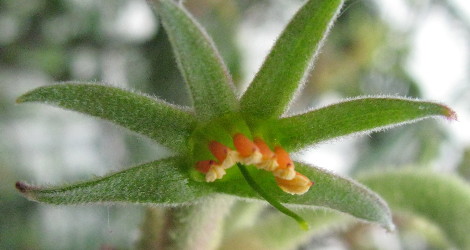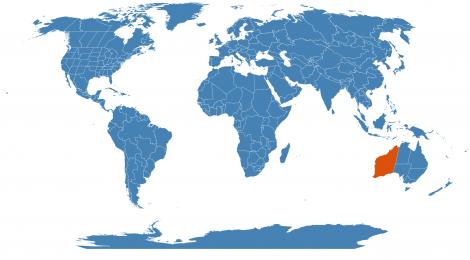Accession Data:
Anigozanthos flavidus Redoute
- Common Name: Tall Kangaroo Paw
- Family: Haemodoraceae
- Description: [syn. Anigozanthos coccineus Paxt.]
Regarded as the hardiest of the kangaroo paws, this species has a vigorous clumping growth habit to 3 ft (1 m) across. With long, dull green leaves, flowering stems 3–5 ft (1–1.5 m) tall, and flowers in green, yellow or soft red tones, this species has proved adaptable to a range of soils and climates. Native to the far southwestern corner of Australia, where it is attractive to native birds, it is used extensively in hybridization programs.
- Culture: They prefer warm, very well-drained sandy or gravelly soil and a hot, sunny, open position. Water well during dry seasons. Most will tolerate very light frosts and do well in coastal regions. Most tolerate summer drought, although flowering will be prolonged with summer water. Propagate by division in spring or from fresh seed. Plants are often affected by ink disease, a fungus which blackens the foliage. Protect from snails which can shred younger leaves overnight.
- USDA Zone: 9-11
Accession Data:
- Accession # 199000072
- Source: Unknown
- Accession Date: 01-01-1990
- Bench: 2106 - MED:Western Australia A
- Currently: active - healthy
- Qty: 2 confirmed on 05-06-2025
Classification:
- Division: Magnoliophyta
- Class: Liliopsida
- SubClass: commelinids
- Order: Commelinales
- SubOrder:
- Family: Haemodoraceae
- SubFamily: Conostyloideae
- Tribe: Conostylideae
- SubTribe:
Flowering Data:
This accession has been observed in bloom on:| Year | Jan | Feb | Mar | Apr | May | Jun | Jul | Aug | Sep | Oct | Nov | Dec | ||||||||||||||||||||||||||||||||||||||||
|---|---|---|---|---|---|---|---|---|---|---|---|---|---|---|---|---|---|---|---|---|---|---|---|---|---|---|---|---|---|---|---|---|---|---|---|---|---|---|---|---|---|---|---|---|---|---|---|---|---|---|---|---|
| 2025 | ||||||||||||||||||||||||||||||||||||||||||||||||||||
| 2024 | ||||||||||||||||||||||||||||||||||||||||||||||||||||
| 2023 | ||||||||||||||||||||||||||||||||||||||||||||||||||||
| 2022 | ||||||||||||||||||||||||||||||||||||||||||||||||||||
| 2021 | ||||||||||||||||||||||||||||||||||||||||||||||||||||
| 2020 | ||||||||||||||||||||||||||||||||||||||||||||||||||||
| 2019 | ||||||||||||||||||||||||||||||||||||||||||||||||||||
| 2018 | ||||||||||||||||||||||||||||||||||||||||||||||||||||
| 2017 | ||||||||||||||||||||||||||||||||||||||||||||||||||||
| 2016 | ||||||||||||||||||||||||||||||||||||||||||||||||||||
| 2015 | ||||||||||||||||||||||||||||||||||||||||||||||||||||
| 2014 | ||||||||||||||||||||||||||||||||||||||||||||||||||||
| 2013 | ||||||||||||||||||||||||||||||||||||||||||||||||||||
| 2012 | ||||||||||||||||||||||||||||||||||||||||||||||||||||
| 2011 | ||||||||||||||||||||||||||||||||||||||||||||||||||||
| 2010 | ||||||||||||||||||||||||||||||||||||||||||||||||||||
| 2009 | ||||||||||||||||||||||||||||||||||||||||||||||||||||
| 2008 | ||||||||||||||||||||||||||||||||||||||||||||||||||||
| 2007 | ||||||||||||||||||||||||||||||||||||||||||||||||||||
| 2006 | ||||||||||||||||||||||||||||||||||||||||||||||||||||
| 2005 | ||||||||||||||||||||||||||||||||||||||||||||||||||||
| 2004 | ||||||||||||||||||||||||||||||||||||||||||||||||||||
References (internal):
- EEB Greenhouse Holdings native to: Western Australia
References (external):
- Guide to Anigozanthos - Australian National Botanic Garden {http://osprey.anbg.gov.au/anigozanthos/index.html - dead link as of last access on Monday, July 24, 2017}
- Botanica, Turner & Wasson, 1997, CD-ROM Version
- Hortus Third, LH Bailey Hortorium, 1976
- The Plant List (2013). Version 1.1. Last accessed on Monday, July 24, 2017.
- WCSP (2016). World Checklist of Selected Plant Families. Facilitated by the Royal Botanic Gardens, Kew. Last accessed on Monday, July 24, 2017.
- Anigozanthos flavidus at Australian National Botanic Gardens. Last accessed on Monday, July 24, 2017.
data regenerated on Sat, 10 May 2025 13:42:44 -0400 [bcm v4.0]
Images:

Additional images for this accession:
Click on thumbnails to enlargeCurrent Accessions in the Haemodoraceae
Subfamily Conostyloideae
Tribe Conostylideae
Subfamily Haemodoroideae
W/C = Wild Collected = indicates flowering in past 14 days
= indicates flowering in past 14 days
 = images available for this accession
= images available for this accession
 = map available for this accession
= map available for this accession
 = accession added within past 90 days
= accession added within past 90 days


